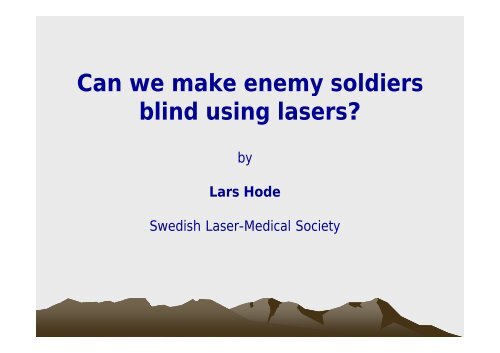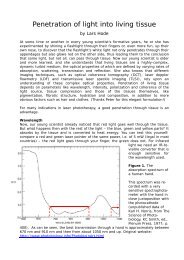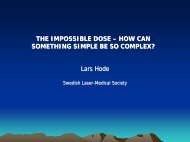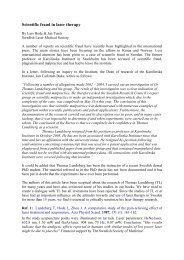Can we make enemy soldiers blind using lasers?
Can we make enemy soldiers blind using lasers?
Can we make enemy soldiers blind using lasers?
Create successful ePaper yourself
Turn your PDF publications into a flip-book with our unique Google optimized e-Paper software.
<strong>Can</strong> <strong>we</strong> <strong>make</strong> <strong>enemy</strong> <strong>soldiers</strong><br />
<strong>blind</strong> <strong>using</strong> <strong>lasers</strong>?<br />
by<br />
Lars Hode<br />
S<strong>we</strong>dish Laser-Medical Society
Background: g<br />
Lasers have long been used by our military forces:<br />
• In distance measurements<br />
• Target pointer in aircrafts for smart bombs<br />
• Target pointer on rifles<br />
• Beam rider for steering missiles<br />
• Flash <strong>blind</strong>er for disturbing missiles and pilots<br />
• Gated viewing through fog<br />
• Green light submarine detection
The classification of <strong>lasers</strong> is almost the same<br />
everywhere in the world, but the rules concerning<br />
civilian use of <strong>lasers</strong> and rules for permission and<br />
registration of instruments vary from country to<br />
country country.<br />
Military use of <strong>lasers</strong> are in most countries not<br />
a y use o ase s a e os ou es o<br />
ruled by civilian laws.
What about laser <strong>we</strong>apons?<br />
If you can cut in steel, then you can destroy an<br />
eye eye. How dangerous are actually different <strong>lasers</strong>?<br />
<strong>Can</strong> Ca <strong>we</strong> e <strong>make</strong> a e so <strong>soldiers</strong> d e s b<strong>blind</strong>? d
Many people think that looking into a laser beam<br />
can <strong>make</strong> them <strong>blind</strong>.<br />
Is that correct?<br />
Yes, there are such <strong>lasers</strong>! I will describe some of<br />
them and show examples.
Output<br />
po<strong>we</strong>r<br />
6 mW<br />
10 meter<br />
Weight<br />
2 gram<br />
10 mm<br />
This laser was never produced.<br />
But it is possible p to <strong>make</strong> it, if<br />
enough money is available.<br />
It was constructed theoretically<br />
under Richard M. Nixons<br />
administration in USA and about<br />
20 units was thought to circulate<br />
in satellites around the earth.<br />
6 MW The intention was to burn<br />
output Russian nuclear missiles when<br />
they came up through the<br />
Weight atmosphere. This laser could<br />
20 ton<br />
possibly <strong>make</strong> you <strong>blind</strong> – it<br />
can cook you.<br />
This laser, laser a laser<br />
diode, often used in a<br />
therapeutic laser<br />
instrument. This laser<br />
can not harm you.<br />
It can possibly help<br />
healing g an injured j<br />
eye!
Before One <strong>we</strong>ek later Two months later<br />
This fibroma was removed with a 15 watt<br />
surgical CO2 laser, 50 mm focal length.<br />
<strong>Can</strong> that laser <strong>make</strong> you <strong>blind</strong>? NO. It might burn the cornea<br />
in or near the focal area, but not <strong>make</strong> someone <strong>blind</strong>!
An Alexandrite<br />
laser for hair<br />
removal.<br />
<strong>Can</strong> this laser<br />
<strong>make</strong> you <strong>blind</strong>?<br />
NO
These <strong>lasers</strong> can <strong>make</strong> you <strong>blind</strong><br />
But they are very expensive very heavy<br />
But they are very expensive, very heavy<br />
and takes a lot of kilowatts to run
This laser can <strong>make</strong> you y <strong>blind</strong><br />
Price: 380,000 €
A Q-switched Nd:YAG-laser – can it <strong>make</strong> you<br />
bl <strong>blind</strong> d if f someone shoots h right h into your eyes? NO
Dart arrows ...<br />
Price: 2.50 €<br />
... can <strong>make</strong> <strong>make</strong> an an eye eye <strong>blind</strong><br />
<strong>blind</strong>
E t ti<br />
Ear protection<br />
must be worn too!
A slingshot can <strong>make</strong> you <strong>blind</strong>. It can be used by<br />
anyone older than 5. It is very cheap. You don’t need a<br />
responsible doctor .....
It would be much safer<br />
if it was a class 4 laser;<br />
they might cause an<br />
injury injury, but they can’t<br />
<strong>make</strong> you <strong>blind</strong>.<br />
Bullet proof vest<br />
must be worn.<br />
No comments ! ! !
Other laser laser risks<br />
risks<br />
High voltage<br />
Warning! High voltage capacitors<br />
are ridiculously dangerous things.<br />
They can store enough energy to<br />
kill you instantly.
Examples of eye<br />
injuries from strong<br />
<strong>lasers</strong>
New England J med 363;11, September 9, 2010<br />
Figure 1. 1 Retinal Injury in a Teenage Boy and Laser Pointers. Pointers<br />
A photograph of the fundus of A photograph of the fundus of<br />
the left eye. y the right eye eye.
What is strange with this report is that this boy has injuries in the<br />
fovea of both eyes. It means that two different “shots†have been<br />
fired fired, first in one eye eye, then in the other. other Such a shot is rather<br />
painful. To get a permanent injury, both high po<strong>we</strong>r and enough<br />
exposure time is needed.<br />
To injure the fovea, you need to look directly into the beam. First<br />
with the laser pointed to one eye and then to the other.<br />
It is difficult to understand that such a thing can happen by<br />
mistake. sta e The e measured easu ed output of o the t e laser ase in tthis s case was as 150 50 mW<br />
and a single s<strong>we</strong>ep over the eyes can not cause such injuries.
Lars is looking into two green laser pointers, 50 mW and 5 mW po<strong>we</strong>r.
From K. L. Barat, photonic Spectra, March 2005<br />
Th Three shots h t from f a<br />
Nd:YAG-laser, from<br />
three different angels<br />
into a rabbit eye,<br />
caused bleeding
From K. L. Barat, photonic Spectra, March 2005<br />
Injury<br />
from a<br />
military y<br />
range<br />
finder;<br />
Nd:YAGlaser.
Very strong laserpulses,<br />
laserpulses<br />
e.g. from Q-switched<br />
<strong>lasers</strong>, can cause<br />
“blooming†blooming and even an<br />
“explosion†in the retina.<br />
So, be aware of Qswitched<br />
<strong>lasers</strong>, they will<br />
not <strong>make</strong> you y <strong>blind</strong>, , but<br />
can cause a serious<br />
injury in the retina.
EEyes can stand t d much h stronger t li light ht than th most t<br />
people believe.<br />
Also, if <strong>we</strong> get an injury, healing processes<br />
starts and the eyes y are no exception. p Eye y<br />
injury healing processes can also be<br />
stimulated by Laser Phototherapy.
Further, , strong g <strong>lasers</strong> are used in the following g eye y<br />
treatments:<br />
Laser trabeculoplasty for open angle glaucoma<br />
Laser iridotomy in pigment dispersion syndrome<br />
Laser photocoagulation for neovascular age-related macular degeneration<br />
Photodynamic Therapy of <strong>we</strong>t macular degeneration<br />
LLaser assisted i t d in i situ it keratomileusis k t il i (LASIK) for f myopia i correction ti<br />
Laser treatment of diabetic retinopathy<br />
Laser treatment of solar retinopathy<br />
Laser treatment of age related macular degeneration<br />
Lasering drusen<br />
Treatment of keratoconjunctivitis with LLLT<br />
Correction of myopia (PRK) and astigmatic keratotomy (AK)<br />
Laser in transpupillary thermotherapy (TTT)<br />
Laser photolysis of cataract<br />
Laser <strong>we</strong>lding of the cornea<br />
Laser posterior capsulotomy<br />
Selective retinal pigment epithelium laser treatment<br />
…. and some other treatments
Also, it is not "laser" light that may be dangerous.<br />
It iis any li light ht of f certain t i po<strong>we</strong>r, and d exposure time, ti in i<br />
certain wavelength interval, with certain pulse energy<br />
(if pulsed) pulsed), with certain geometric configuration<br />
(divergence, solid angle) etc that may cause such<br />
irradiation in the retina that the MPE (maximum (<br />
permissible exposure) is exceeded much enough.<br />
E l f h li ht IPL t fl h<br />
Examples of such light sources are IPL, strong flash<br />
lamps, certain xenon arc lamps.
Are A AAre there th good d protection t ti possibilities? ibiliti ?<br />
Yes, most important is knowledge!<br />
Laser safety glasses are very efficient but there<br />
is a risk:<br />
If you use the wrong type type, you may think that<br />
you are protected, but may be not.
Then, what <strong>make</strong>s some<br />
<strong>lasers</strong> dangerous?
There are certain risk factors, which?<br />
Summary of risk factors<br />
1. High g ppo<strong>we</strong>r<br />
2. Long exposure time<br />
3. Parallel beam<br />
4. Not visible wavelength<br />
5. Small beam diameter<br />
66. Extreme pulsing (e (e.g. g QQ-switching) switching)<br />
7. Using a binocular when looking into a laser.<br />
1. Extended source / several sources<br />
decreases the risk.
Narrow beam - one of the risk factors<br />
A wide beam is less hazardous to an eye than a narrow beam because<br />
only a fraction passes through the pupil, the rest comes outside.
Classification of <strong>lasers</strong> – laser<br />
classes<br />
Parameters:<br />
Laser type<br />
Wavelength<br />
OOutput t t po<strong>we</strong>r<br />
Divergence<br />
Extended source<br />
Pulsing<br />
The classification of <strong>lasers</strong> is one of the procedures that are included in the so<br />
called CE-approval containing a lot of international standards.<br />
A classified l ifi d llaser will ill bbelong l tto one of f th the groups 1 – 44.<br />
1, 2, 3R 3A, 3B 4<br />
In S<strong>we</strong>den, <strong>lasers</strong> in these groups are free to use. Doctor or<br />
dentist
An eye is working like a digital camera where the retina<br />
is a detector matrix with millions of pixels in the form of<br />
light g sensitive cells. When these cells are hit by y visible<br />
light, they are producing a nerve signal. From this signal,<br />
our brain is building up an image.<br />
When looking against the sun, the image will be a<br />
picture of the sun with sun spots and all. In the case of<br />
an unpleasant l t iintensity, t it our bli blink k reflex fl i is †â€switching it hi offâ€, ffâ€<br />
first by blinking then by turning your head.
A parallel beam is depicted at the retina as a small point.<br />
The eye<br />
pupil<br />
iris<br />
cornea<br />
aqueous<br />
humour<br />
eye lid<br />
sclera<br />
muscle<br />
muscle<br />
sclerotic coat<br />
choroid<br />
retina<br />
optic nerve<br />
fovea<br />
( (yellow ll<br />
spot)
Laser<br />
Beam divergence.<br />
â—<br />
Size of pupil 7 mm ø<br />
Size of beam 10 cm ø
•<br />
Green laser pointer<br />
was used to attack the<br />
<strong>we</strong>ll known football<br />
player Lionel Messi.<br />
The spot is encircled on<br />
the figure g to the left. In<br />
the news paper article<br />
it was said: â€He could<br />
have been <strong>blind</strong>!â€<br />
Size of a pupil.<br />
About 0.1% 0 1% of the<br />
laser light can pass<br />
through the pupil.<br />
If the laser po<strong>we</strong>r<br />
is 100 mW, about<br />
0.1 mW can reach<br />
the retina.<br />
retina
Let us assume a Q-switched Nd:YAG-laser for distance<br />
measuring. Aperture diameter 7 mm, beam divergence<br />
1 mrad d and d pulse l energy 1 J. J Just J t in i front f t of f the th laser l<br />
this can cause a serious retinal injury.<br />
Energy density outside aperture is 2.6 J/cm2 and at 100<br />
meter distance (it ( has then a diameter of 10 cm) ) the<br />
energy that can pass through a pupil with a diameter of<br />
7 mm is 0.005 J. This is not enough to cause an injury<br />
unless l the th target t t person iis llooking ki directly di tl at t the th laser l<br />
with binoculars in the moment of firing.
The pupil p p is limiting g<br />
the laser po<strong>we</strong>r that is<br />
entering into the eye.<br />
2 cm wide laser beam<br />
The focused<br />
laser beam<br />
has a<br />
di diameter t in i<br />
the order of<br />
a few micro<br />
meter
The lens is foc<strong>using</strong> the<br />
laser beam on the retina retina.<br />
The focus point has a<br />
diameter in the order of a<br />
few micro meters meters. A<br />
possible retinal burn is<br />
very small.<br />
Retina<br />
Lens<br />
The focused<br />
laser beam.
Different directions<br />
If two strong <strong>lasers</strong> hit the<br />
eye from two different<br />
directions, there will be<br />
two retinal burns.<br />
Ho<strong>we</strong>ver, in order to <strong>make</strong> a<br />
person <strong>blind</strong>, a lot of burning<br />
with many different incident<br />
angles g have to be<br />
performed.<br />
Two<br />
retinal<br />
burns
Treatment with two HeNe-<strong>lasers</strong>
Wavelength g<br />
as risk<br />
factor<br />
Different<br />
risk i k llevels l<br />
in different<br />
parts of the<br />
spectrum.
Therapeutic <strong>lasers</strong> (usually in<br />
laser class 3B) ...<br />
... are practically risk free. Fear<br />
of <strong>lasers</strong> cause more problems<br />
than the <strong>lasers</strong> themselves do.<br />
Therapeutic <strong>lasers</strong> are usually in<br />
the po<strong>we</strong>r region 1 - 500 mW.<br />
Therapeutic <strong>lasers</strong> can cure<br />
many eye diseases
Low-Level Laser Therapy Improves Vision in<br />
Patients with Age Age-Related Related Macular Degeneration<br />
Boris T. Ivandic, M.D., and Tomislav Ivandic, M.D.<br />
Results: LLLT significantly improved visual acuity (p< 0.00001<br />
versus baseline) ) in 162/182 / ( (95%) ) of eyes y with cataracts and<br />
142/146 (97%) of eyes without cataracts. The prevalence of<br />
metamorphopsia, scotoma, and dyschromatopsia was reduced.<br />
IIn patients ti t with ith <strong>we</strong>t t AMD AMD, edema d and d bleeding bl di improved. i d The Th<br />
improved vision was maintained for 3–36 months after treatm.<br />
Photomedicine and Laser<br />
Surgery, volume 26, Nr 3,<br />
2008. Pp. 241 241–245 245
Conclusion:<br />
LLasers are of f very llow risk i k compared d to: t<br />
Dart arrows.<br />
Ai Air guns.<br />
Knives.<br />
Stones thrown thrown.<br />
Slingshots.<br />
Practically all <strong>we</strong>apons.<br />
Broken branches on trees in the forest.<br />
Fireworks<br />
Acids<br />
etc
There are stories about <strong>soldiers</strong><br />
that have been <strong>blind</strong> by <strong>lasers</strong>.<br />
They are not true.<br />
Eye injuries – yes – but nobody<br />
got <strong>blind</strong> from a laser. Any laser.
Nobody,<br />
... yes, nobody has become <strong>blind</strong> from a<br />
laser. Any y<br />
laser.
Thanks for listening





